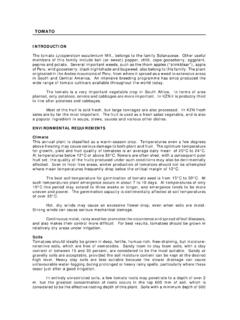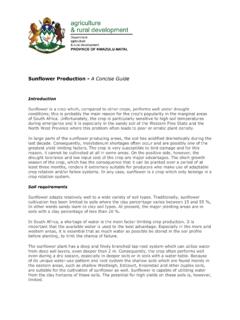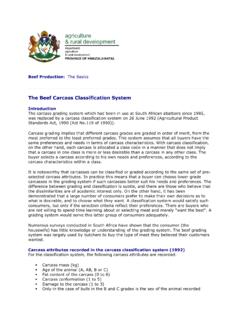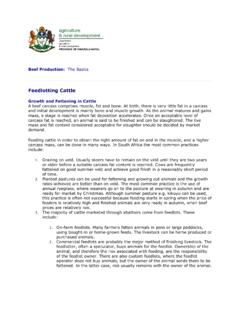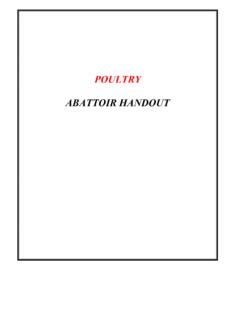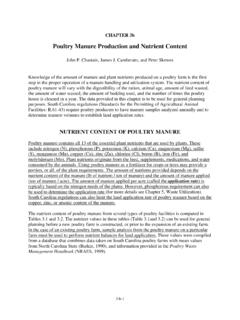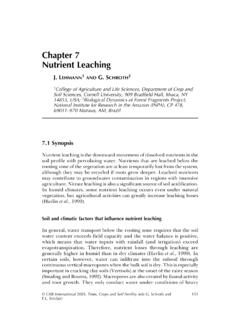Transcription of PLANT POPULATIONS & PLANT SPACINGS
1 PLANT POPULATIONS & PLANT SPACINGSP lant population refers to the NUMBER of plants per unit area of :40 000 plants per hectare ( cabbage) or100 plants per square metre ( carrot) PLANT spacing , on the other hand, refers to the ARRANGEMENT of plants on the area :Widely varying PLANT SPACINGS such as 1 000 mm x 10 mm, 500 mm x 20mm and 100 mm x 100 mm, all give a PLANT population of 100 plants persquare : What is the optimum population or spacing for a specific vegetable crop?There is no precise answer to this question. Factors such as climate, soil, cultivar, marketrequirements, managerial ability of the grower, and many others, all play a role. For thisreason, one will often find that a range of SPACINGS or POPULATIONS is recommended. Forexample, a recommendation for cabbage may be a PLANT spacing of 350 mm to 500 mm in rowsdrawn 500 mm to 700 mm apart, and a PLANT population of 35 000 to 45 000 plants perhectare.
2 At any specific PLANT population , individual plants are likely to perform best where auniform spacing of plants , equidistant from one another in all directions, is adopted. However,it is usually more practical to PLANT fairly closely in rows, with the rows being spaced widerapart. This allows for easier access into the planting for inspections, weeding, pest and diseasecontrol and size and shape of the root system of most plants are generally in proportion to thesize and shape of their top growth. Thus we find that plants like lettuce, cabbage andcauliflower, with a fairly compact "rounded" top growth, generally have compact, rounded root-systems, but lettuce, being smaller, should be planted closer together than cabbage foroptimum yields. Also, a large, vigorous cauliflower cultivar, like Snowcap, is usually plantedat a population density of about 20 000 plants per hectare, while 30 000 or 35 000 plants perhectare is more appropriate for the smaller Glacier (short), more upright growing crops, like onion or carrot, have relativelyshallow roots, with limited lateral (sideways) crops, such as pumpkin, Hubbard squash or butternut,on the other hand, tendto have rather sparse, but spreading, root-systems, similar in size and spread to that of thetop growth.
3 Butternut, being less vigorous than the others mentioned, requires a closer spacing (a higher PLANT population ) for optimum cases where climate, soil and nutrient status are all favourable for growth, plants willgrow larger and have better-developed root-systems and this could require a wider thannormal spacing . A lower PLANT population is also justified when conditions such as limited soilmoisture are a likely limitation to the an understanding of a PLANT s growth behaviour, and the conditions under whichit is to be grown, it is possible to make a good estimate of a suitable PLANT spacing for mostvegetable :What would happen if the PLANT density of a vegetable crop was increased furtherafter reaching a population which gives an acceptable economic yield?Generally the total yield would at first still increase, eventually reaching a peak, and thereafteryield would decline as inter- PLANT competition became too , the response to higher PLANT densities differs in several respects betweenfruiting crops, such as pea, bean, chilli, tomato and pumpkin, on the one hand, and non-fruitingcrops, such as carrot, beetroot, potato, cabbage, spinach and sweet corn, on the main differences in response to increasing PLANT densities, within the acceptable populationranges for these two groups of crops, are summarised below.
4 Fruiting CropsNon-Fruiting CropsRange of acceptablepopulationsWide (5 to 10 times)Narrow (1 to 2 times)Yield per hectareIncreaseIncreases at expense ofproduct sizeYield per plantReducedGreatly reducedSize of productLittle effectMarkedly reducedHarvest periodConcentratedLengthenedEarliness of harvestEarlier main cropMain crop is delayedIn practice these differences in response can be effectively used to achieve certain example, high-density POPULATIONS are utilised for once-over mechanical harvesting ofprocessing tomatoes, green beans or green peas, where a concentrated crop maturity isessential for good yields. Also, where the market demand calls for smaller-sized products, suchas "baby carrots" or mini-cauliflowers, density of the plantings is also increased, often to thepoint of reducing total yields in order to produce the required size (this may be a viable optionprovided premium prices are offered for such produce).
5 Where crops are grown under less favourable conditions, the plants tend to be smallerthan normal, and increasing the population slightly would normally be advantageous,particularly for fruiting crops. Slightly denser plantings are, in any event preferred becausethey are more likely to allow for an acceptable final population density to be achieved, evenwhen PLANT losses are slightly greater than expected. Bear in mind that, for most vegetablecrops, the percentage loss in yield due to PLANT losses is usually half that of the percentage ofplant loss, a 20% loss of plants results in about a 10% yield loss.


